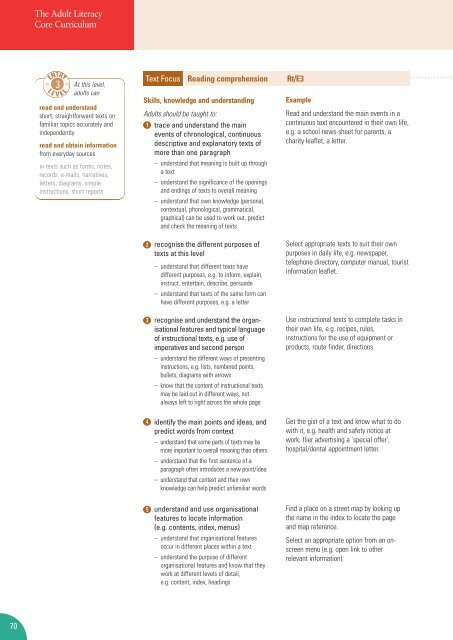Adult Literacy Core Curriculum - Nationally developed Skills for Life ...
Adult Literacy Core Curriculum - Nationally developed Skills for Life ...
Adult Literacy Core Curriculum - Nationally developed Skills for Life ...
Create successful ePaper yourself
Turn your PDF publications into a flip-book with our unique Google optimized e-Paper software.
70<br />
The <strong>Adult</strong> <strong>Literacy</strong><br />
<strong>Core</strong> <strong>Curriculum</strong><br />
At this level,<br />
adults can<br />
read and understand<br />
short, straight<strong>for</strong>ward texts on<br />
familiar topics accurately and<br />
independently<br />
read and obtain in<strong>for</strong>mation<br />
from everyday sources<br />
in texts such as <strong>for</strong>ms, notes,<br />
records, e-mails, narratives,<br />
letters, diagrams, simple<br />
instructions, short reports<br />
Text Focus Reading comprehension Rt/E3<br />
<strong>Skills</strong>, knowledge and understanding<br />
<strong>Adult</strong>s should be taught to:<br />
1 trace and understand the main<br />
events of chronological, continuous<br />
descriptive and explanatory texts of<br />
more than one paragraph<br />
– understand that meaning is built up through<br />
a text<br />
– understand the significance of the openings<br />
and endings of texts to overall meaning<br />
– understand that own knowledge (personal,<br />
contextual, phonological, grammatical,<br />
graphical) can be used to work out, predict<br />
and check the meaning of texts<br />
2<br />
3<br />
4<br />
5<br />
recognise the different purposes of<br />
texts at this level<br />
– understand that different texts have<br />
different purposes, e.g. to in<strong>for</strong>m, explain,<br />
instruct, entertain, describe, persuade<br />
– understand that texts of the same <strong>for</strong>m can<br />
have different purposes, e.g. a letter<br />
recognise and understand the organisational<br />
features and typical language<br />
of instructional texts, e.g. use of<br />
imperatives and second person<br />
– understand the different ways of presenting<br />
instructions, e.g. lists, numbered points,<br />
bullets, diagrams with arrows<br />
– know that the content of instructional texts<br />
may be laid out in different ways, not<br />
always left to right across the whole page<br />
identify the main points and ideas, and<br />
predict words from context<br />
– understand that some parts of texts may be<br />
more important to overall meaning than others<br />
– understand that the first sentence of a<br />
paragraph often introduces a new point/idea<br />
– understand that context and their own<br />
knowledge can help predict unfamiliar words<br />
understand and use organisational<br />
features to locate in<strong>for</strong>mation<br />
(e.g. contents, index, menus)<br />
– understand that organisational features<br />
occur in different places within a text<br />
– understand the purpose of different<br />
organisational features and know that they<br />
work at different levels of detail,<br />
e.g. content, index, headings<br />
Example<br />
Read and understand the main events in a<br />
continuous text encountered in their own life,<br />
e.g. a school news-sheet <strong>for</strong> parents, a<br />
charity leaflet, a letter.<br />
Select appropriate texts to suit their own<br />
purposes in daily life, e.g. newspaper,<br />
telephone directory, computer manual, tourist<br />
in<strong>for</strong>mation leaflet.<br />
Use instructional texts to complete tasks in<br />
their own life, e.g. recipes, rules,<br />
instructions <strong>for</strong> the use of equipment or<br />
products, route finder, directions.<br />
Get the gist of a text and know what to do<br />
with it, e.g. health and safety notice at<br />
work, flier advertising a ‘special offer’,<br />
hospital/dental appointment letter.<br />
Find a place on a street map by looking up<br />
the name in the index to locate the page<br />
and map reference.<br />
Select an appropriate option from an onscreen<br />
menu (e.g. open link to other<br />
relevant in<strong>for</strong>mation).

















